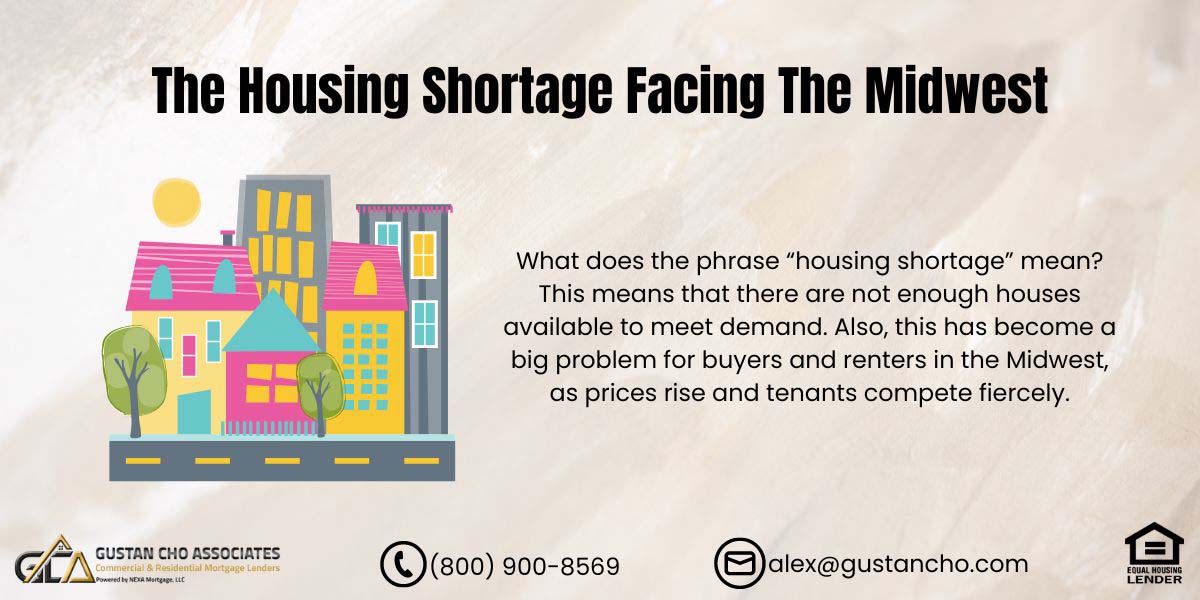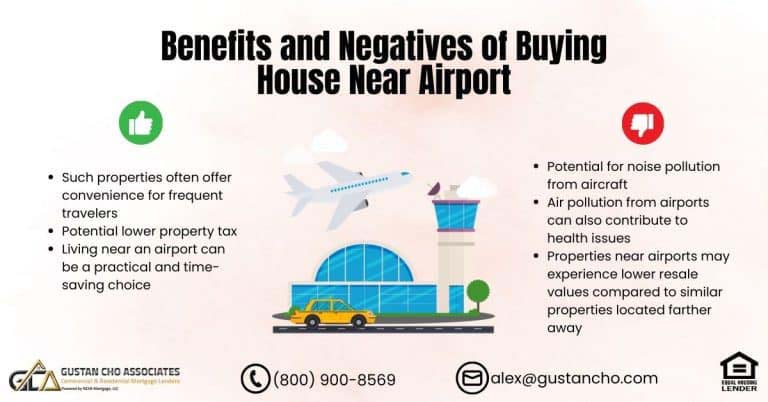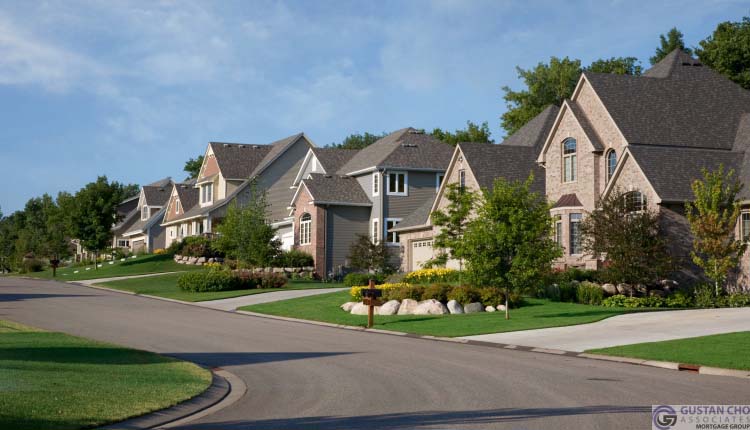This guide covers the housing shortage facing the Midwest. The housing shortage in the Midwest has impacted and affected homebuyers in the Midwest. While home sellers enjoyed the multiple offers on their listed homes, many homebuyers were affected by multiple offers on the same property.
There is not a homebuyer who did not have been in a bidding war on a property. Most homebuyers needed to bid over the list price to get the winning bid. Paying 10% or more over the list price was becoming the norm.
The housing market has been facing a housing shortage nationally since 2012. However, despite the historic skyrocketing mortgage rates, home prices increased with no signs of correction. The demand for homes for homebuyers far surpassed the high rates and soaring inflation. The housing shortage is forecast to continue as more renters plan on becoming homeowners. The demand for housing is expected to outpace the inventory of homes. The following paragraphs will cover the Midwest states’ housing shortage.
Introduction to the Midwest Housing Shortage Crisis
The Midwest has long been considered the heartland of America, a region known for its friendly Midwestern values and a strong sense of community. However, in recent years the Midwest has been facing a housing crisis that is quickly making it one of the most expensive regions in the country to live in.
The problem began during the housing boom of the early 2000s when prices for single-family homes in the Midwest started to rise at an unprecedented rate. The rise was partly due to investors from coastal regions buying up properties in the Midwest as second homes or investment properties, driving up prices even further.
At the same time, many young people were moving to the Midwest for jobs in the burgeoning tech and startup industries. With more people competing for fewer homes, prices skyrocketed, leaving many middle-class families out of the market. With more people competing for homes, the situation worsened because new construction needed to catch up with demand, resulting in a severe shortage of affordable housing options.
Facing the Midwest Housing Shortage? Let Us Help You Find Your Dream Home!
Contact us today to explore available options and secure the financing you need in this competitive market.
How The Volatile Housing Markets Created Accelerated The Housing Shortage
After the Federal Reserve Board lowered interest rates to zero percent in 2019, mortgage rates have tanked to historic record lows. 30-year fixed-rate mortgages have dropped to 2.5% in early 2021, and the 15-year fixed-mortgage rate dropped below 2.0% for prime credit borrowers.
Renters who were not planning on buying a home until years later decided to pull the trigger on a home purchase and take advantage of historically low rates. Unfortunately, homebuyers were facing a dilemma. The minute a home was listed, dozens of buyers were interested in placing a bid on the home.
Home sellers were selling their homes significantly higher than the list price. Even though homes were not appraising at prices over list prices, homebuyers were getting the money to purchase the home. Lenders will only base the home’s market value on the appraised value of the home and not the purchase price. Therefore, for any amount buyers pay over the appraised value, the buyer must come up with cash out of pocket. Today, mortgage rates have soared to over 7.0%. Despite record-high rates and soaring inflation, demand for homes remain high due to the housing shortage. The housing shortage in Midwest states is reaching a crisis level.
How The Housing Shortage Is Affecting Homebuyers
HUD and the Federal Housing Finance Agency have increased FHA and Conventional loan limits for the past seven years due to the skyrocketing home prices. The housing shortage was becoming a crisis throughout the country. Pre-approved homebuyers were seeing home prices skyrocket before their eyes.
Some homebuyers were frightened the way home prices were skyrocketing that, they were going to get priced out of the housing market. Undoubtedly, it was a seller’s market and will continue to be a seller’s market for months and years.
This has driven home prices to record high levels pricing many homebuyers gave up and got out of the housing market. Countless pre-approved homebuyers at Gustan Cho Associates had to wait over a year to get a winning bid on a house during the housing shortage of 2020 and 2021. Many homebuyers got priced out of the housing market due to high rates and soaring home prices.
How The Housing Boom Affected Homebuyers Get Seller Concessions
Most homebuyers depend on seller concessions to pay their home’s closing costs. The team at Gustan Cho Associates are experts in helping homebuyers during the housing shortage. John Strange, a senior loan officer at Gustan Cho Associates, explains how the team at Gustan Cho Associates are experts in helping homebuyers get seller concessions to cover closing costs as follows:
We can help negotiate with the sellers or the seller’s real estate agent on getting the homebuyer a seller concession so they can cover their closing costs. If the homebuyer is short to cover closing costs due to insufficient seller concessions, the lender can offer a lender credit.
Lender credit only applies to borrowers with higher credit scores. A lender credit works because the lender will charge a higher mortgage rate instead of giving the borrower a cash credit to cover the closing costs. However, a maximum cap is on how much a lender can charge on residential government or conventional loans.
Housing Market Forecast For 2023
Home prices are forecasted to keep increasing, making it harder for homebuyers to purchase a home in the Midwest. Borrowers with lower credit scores can only be charged a certain rate, so lender credit may not be available. We realize this can get confusing, so contact us if you need further explanations on this topic or other mortgage/real estate-related topics at gcho@gustancho.com.
Nobody has a crystal ball, and the housing correction went the other way. Housing prices increased like never before. Home prices are expected to keep increasing for the next several years from all the data and outside factors with low-interest rates and the economy.
We can go over this concept over the phone in great detail so there are no misunderstandings. In this article, we will discuss and cover the housing shortage facing homebuyers shopping for a new home. We will also cover how long the housing shortage will last and how it will affect home prices.
Coronavirus Outbreak Created Demand For Homes Furthering The Housing Shortage
The coronavirus outbreak in February 2020 has changed many companies’ business models. Most companies in the United States have changed their business models to change a significant percentage of their workforces to remote positions.
Remote workers can now live anywhere in the nation. They no longer have to be close to their workplace. A large percentage of America’s workforce is not remote workers.
Many remote workers who used to live in states with high home prices, such as California and New York, can now relocate to lower-taxed states with affordable housing, such as Tennessee, Indiana, Georgia, Florida, Texas, Alabama, Ohio, Missouri, North Carolina, South Carolina, Michigan, and other states. Substantial renters and millennials have flooded the home-buying market, fueling the housing shortage’s fire.
Mortgage Programs Outside of Government and Conventional Loans
Having alternative mortgage loan programs for homebuyers who could not qualify for traditional mortgages has spiked the housing demand and added more homebuyers in a short housing shortage market. The housing shortage is not as bad as it was in early 2021.
Since demand outpaces the inventory of homes, prices continue to increase. Bidding wars are expected to become the new norm. It is perfectly okay for home prices to keep increasing as long as it increases steadily.
Skyrocketing home prices like the double-digit returns we have seen the past few years can be dangerous. If home prices suddenly skyrocket, then there can be a correction. With many city dwellers exiting city life as renters, shopping for single-family homes in the suburbs, and the mass conversion of remote workers in the workplace, home prices are expected to increase more than previously. Many factors have caused the sudden double-digit increase in home prices in the past few years.
What Factors Are Causing The Housing Shortage
The housing shortage the United States has been experiencing for the past several years is due to multiple factors. It started with the 2008 Great Recession and the housing meltdown. When the nation was going through the housing meltdown, foreclosure homes were getting purchased by individual and private equity investors in bulk. Home construction came to a halt.
Over 200,000 homes were purchased by investors and used as short-term rentals. Home construction came to an abrupt halt until 2012. This is a lag of almost four years where homes were not being built. The home construction industry was idle. There was a lot of catching up with building new homes and catch up with the downtime when home construction sat idle.
Other factors escalated the demand for homes besides the shortfall of new homes from 2008 until 2012. The Federal Reserve Board reducing interest rates to zero percent and the coronavirus outbreak in February 2020 were major factors that increased demand for homes. Some homebuyers put their plans on buying a home on hold after the coronavirus outbreak hoping there may be a housing correction.
Struggling to Find a Home in the Midwest Housing Market? We’ve Got Solutions!
Reach out today to learn about your financing options and get pre-approved.
The Midwest’s Surprising Lack of Affordable Housing Options
Were you looking for affordable housing in the Midwest? You might be surprised that it’s more challenging than you think. Despite being known for its affordability and quality of life, the Midwest faces a housing crisis that has left many struggling to find suitable living arrangements.
The Midwest’s lack of affordable housing opti ons is a serious problem that has been largely overlooked. With the rapid rise in home prices, many people cannot find homes within their budget, which can have lasting effects on families and communities.
It is important for state governments to take action and create more affordable housing options so that everyone has access to safe and comfortable living conditions. This blog post explores why the Midwest’s lack of affordable housing options is becoming increasingly problematic and how to overcome the obstacle. Read on to learn more!
Housing Prices in The Midwest
Today, the average price of a home in the Midwest is nearly double what it was just a decade ago, and rents have increased by nearly 60%. This has strained families struggling to make ends meet and has forced many into homelessness or onto waiting lists for government-subsidized housing.
Several factors have contributed to the Midwest housing crisis. One is the loss of manufacturing jobs in the region, which has led to decreased wages and increased poverty.
Another factor is the increasing cost of housing, which has made it difficult for people on fixed incomes or low incomes to keep up with rent or mortgage payments. There is no easy solution to this crisis, but it is clear that something needs to be done to address the need for more affordable housing options in the Midwest. The Midwest housing crisis is a problem that has been escalating for years.
Population Growth Is Adding Demand For Homes Despite The Housing Shortage
Gustan Cho Associates has added dozens of new non-QM and alternative mortgage loan products, such as non-QM loans one day out of bankruptcy or foreclosure, which added more renters who could not qualify for traditional mortgages able to qualify.
Due to being a seller’s market with multiple offers on a home, many sellers were not offering any seller concessions on a home purchase. Not getting a seller concession by the seller is a major negative on the homebuyer.
The region has seen a decrease in the availability of affordable housing and an increase in the number of people who are homeless or at risk of becoming homeless. The problem is exacerbated by the fact that many of the region’s cities are experiencing population declines, which means fewer potential renters or buyers for the existing housing stock.
The Housing Shortage in the Midwest of Affordable Homes
The problem is also compounded by the fact that there is a limited supply of affordable housing options in many Midwest cities. The consequences of the Midwest housing crisis are far-reaching. They include increased homelessness, evictions, and foreclosures; strains on social service providers; and negative impacts on mental health and overall well-being.
There are several ways to address the Midwest housing crisis, but it will require commitment from all government and private sector involvement. Some possible solutions include investing in affordable housing initiatives.
The housing shortage crisis also disproportionately affects people of color and other marginalized groups, who often have fewer resources and safety nets to fall back on when they experience housing insecurity or homelessness.
What State has the Worst Housing Shortage?
In the Midwest, in 2024 Indiana has the worst housing shortage. Amongst extremely low income households, the state is one of those with both the least availability and affordability of homes for renting. Namely, only about thirty four rentals out of each one hundred rented out units are available to this group in the state. Its rate whereby this kind of rental homes are offered is lower than average nationally and fares poorly amongst other regional states. Therefore, it is a matter of concern that there are deficits in housing which make most residents not capable of affording basic needs such as shelter.
Causes of the Housing Shortage in the Midwest
There are many causes for the housing shortage in the Midwest. One is that the region has experienced significant population growth in recent years, while the number of homes available has not kept pace. This is especially acute in cities like Chicago and Minneapolis, which have seen a boom in young professionals seeking jobs in the growing economy. Another factor is that many available homes are too expensive for most people.
The median home price in the Midwest is over $200,000, while the median income is only around $50,000. This means that even if people could find a place to live, they would be spending a huge chunk of their income on housing costs.
There is a need for more affordable rental options in the Midwest. According to a recent report, nearly half of all renters in the region are considered “cost-burdened,” meaning they spend more than 30% of their income on rent. This leaves little room for other expenses and can make saving up for a down payment on a home difficult. The housing shortage in the Midwest is having a ripple effect throughout the economy.
How The Economy in the Midwest Affects The Labor Market
Businesses are struggling to find workers as help; they need help to afford to live near their job sites. Families are forced to move further away from urban areas in search of more affordable housing options. And low-income renters are being pushed out of neighborhoods as gentrification drives up rents. Who is most affected by the shortage?
In the Midwest, the lack of affordable housing options affects people of all income levels. The most affected are those with low-income or fixed incomes, such as seniors on Social Security or people with disabilities. People who are employed but don’t make much money struggle to find affordable housing.
A recent study found that nearly half of all renters in the Midwest spend more than 30% of their income on rent, which is considered unaffordable. Again the shortage of affordable housing is also impacting families and children. Many communities need to be safe and affordable places for families to live. This can lead to homelessness or families having to move frequently, disrupting children’s education and stability.
Factors Affecting Affordable Housing Options in Midwest States
Many factors contribute to the Midwest’s lack of affordable housing options, but one of the most significant is the region’s rapidly growing population. According to the latest Census data, the Midwest’s population grew by nearly 5% between 2010 and 2018, while the number of housing units in the region increased by just 3%. This imbalance has led to a tight housing market and rising prices, disproportionately affecting low- and middle-income families.
A recent study found that nearly half of all renters in the Midwest are considered “cost-burdened,.” This leaves little room for other essentials like food, transportation, and healthcare. For those already struggling to make ends meet, the shortage of affordable housing options can be devastating.
If you or someone you know is struggling to find affordable housing in the Midwest, some resources are available to help. Your local Housing Authority or community development office is a good place to start. They can provide information about available programs and assistance—strategies for improving affordable housing options in the Midwest.
Midwest Housing Shortage Got You Stressed? Let Us Help You Find Your Home!
Contact us today to discuss how we can help you secure a mortgage and find the home you’re looking for.
How To Improve Conditions For Affordable Housing in Midwest States
Many strategies can be implemented to improve affordable housing options in the Midwest. One strategy is to increase funding for affordable housing initiatives at the local, state, and federal levels. Another strategy is incentivizing developers to build more affordable housing units.
Zoning laws and regulations can be reformed to allow for more density and mixed-use developments, which can help increase the affordable housing supply. One way to increase funding for affordable housing initiatives is through public-private partnerships.
Chicago has partnered with many private companies and philanthropic organizations to create the Chicago Community Catalyst Fund, which will provide $100 million in financing for affordable housing developments. Private companies can also be incentivized to invest in affordable housing through tax breaks or other financial incentives. Zoning laws and regulations are often a barrier to increasing the supply of affordable housing.
Less Zoning Regulations To Make Cost To Build Affordable
In many cases, these laws limit the density that can be built in an area, which drives up the cost of land and construction. Reforming these laws could help make building more affordable housing units easier and more cost-effective.
Changing zoning regulations to allow for more mixed-use developments could also help increase the supply of affordable housing and provide residents with access to essential amenities and services.
There is no one-size-fits-all solution to the affordable housing crisis in the Midwest. But there are several strategies that communities and policy-makers can pursue to address the problem. One way to increase the supply of affordable housing is to make it easier for developers to build more units. This can be done by streamlining the permitting process, incentivizing developers who create affordable units, and reforming zoning laws for more density.
Preserving Existing Subsidizing Housing Units
Another approach is to create or preserve existing subsidized housing units. This can be done through public-private partnerships, using public funds to buy and rehabilitate properties, or creating community land trusts. In addition, policies can be put in place to help low-income families afford rent.
The Housing Choice Voucher program helps families with limited incomes cover a portion of their rent payments. Other options include increasing funding for affordable housing programs or providing tax breaks for renters.
Regardless of the strategy, involving all stakeholders in decision-making will be important – from residents and community groups to developers and government officials. Only by working together will we find lasting solutions to the affordable housing crisis in the Midwest.
Creative Solutions To The Housing Shortage Crisis in Midwest States
What are some creative solutions to the housing shortage problem? The Midwest has a surprising lack of affordable housing options. This is due to several factors, including the region’s declining population, the high cost of living in rural areas, and the lack of investment in affordable housing initiatives.
There are many creative solutions to this problem. Creating incentives for developers to build more affordable housing will stimulate housing starts and more homes. This can be done by providing tax breaks or other financial incentives as well as lax zoning laws and relaxing environmental regulations.
Another solution is creating community land trusts to help decrease housing costs. Another solution is to encourage the development of micro-housing units that are smaller than traditional apartments and can be more affordable.
Is Buying Real Estate in the Midwest a Good Investment?
There is no one-size-fits-all solution to the affordable housing crisis in the Midwest, but some creative solutions have been effective in other regions. One solution is to create incentives for developers to build more affordable housing.
Midwest cities can solve the housing shortage by encouraging home developers with incentives. This can easily get resolved by offering tax breaks, zoning changes, or other financial incentives.
Another creative solution to spark housing growth is increasing funding for affordable housing programs. This can be done at the local, state, or federal level. It is important to promote policies that encourage mixed-income housing developments. This ensures that low- and middle-income families can access quality housing options.
Is Buying Real Estate During The Housing Shortage a Good Investment
Investing in affordable housing will help individuals and benefit entire cities by creating jobs, boosting local economies, and providing stability to communities. If you should decide to buy, before you begin looking for a home and during the process, we have vast experience working with buyers to get them ready to purchase their dream home.
Sonny Walton, a dually licensed realtor and licensed loan officer at Gustan Cho Associates, and her team can take you through your home loan’s entire buying and financing process. Sonny Walton or one of her experienced associates can also can connect you to title companies, home inspectors, general contractors, handymen, landscapers, loan officers, financial advisors, accountants, attorneys and real estate agents in your area that can help as needed.
Call or text us at 800-900-8569 or email at alex@gustancho.com for more information and further assistance. Sonny Walton is an experienced referral agent, a dually licensed real estate agent, and a mortgage originator. She has successfully guided many homeowners through obtaining a home on both the lending and real estate side. She does not represent buyers or sellers but offers free consultation in 48 states at Gustan Cho by connecting homeowners, buyers, and sellers to the needed sources.
FAQs: The Housing Shortage Facing The Midwest
- 1. What does the phrase “housing shortage” mean? This means that there are not enough houses available to meet demand. Also, this has become a big problem for buyers and renters in the Midwest, as prices rise and tenants compete fiercely.
- 2. How have homebuyers been affected by the housing shortage in the Midwest? Certain states’ homebuyers must engage in bidding wars or pay above listing price just so they can beat everyone else out of purchasing at an auction sale. Therefore, many buyers have paid over 10% more than they purchased homes for, hoping to sell one house at a premium.
- 3. Why is there a housing shortage in the Midwest? The condo boom started early 2000’s has resulted in mid-west with less stock of homes that are inadequate to cater for investors who bought properties. Furthermore, there were movements of population due to employment growth as well as slow new construction. In turn, higher mortgage rates plus increased demand worsened affordability problems through limiting supply of affordable housing.
- 4. What are some specific challenges caused by the housing shortage? This leads to bidding wars where purchasers compete aggressively forcing them into paying excessive amounts for their properties. Further, many potential buyers can no longer afford homes owing to continuous rising property values. Nonetheless, even though mortgages topped off and limited availability prevailed on listings; however demand remained high because few properties were up for sale. Similarly low inventory fails to keep pace with growing demands within real estate market.
- 5. How has the coronavirus pandemic affected the housing shortage? Popular regions such as California’s Bay Area witnessed an exodus during Covid-19 lockdowns as remote working became an option causing a large number of people during lockdown migrated from expensive areas like San Francisco Bay Area into considerably inexpensive regions such as Midwest further depleting already low levels of housing stock.
- 6. Are there any solutions being implemented to address the housing shortage? These encompass funding for affordable homes, incentives for developers to construct more houses and zoning policies allowing denser residential developments. However, it takes time before these measures can be finally put in place.
- 7. How has the housing shortage impacted renters in the Midwest? The current circumstances impact both renters and cause rental prices to rise, thus creating challenges for low and middle-income families in finding reasonably priced housing. Most of their income is spent on rent leaving them with a small figure allocated on other basic needs.
- 8. What can potential homebuyers do in this competitive market? In light of such a competitive market scenario, potential homeowners should act swiftly when they find a good property. Moreover, they might want to consider getting pre-approved for financing so that their offer would be stronger. Some professional brokers may also come handy during such period since they have been negotiating through these tight times. Finally, buyers should not discount bargaining with sellers as well as paying beyond the listing price.
- 9. Is there any relief in sight for the housing shortage in the Midwest? Although experts predict this scarcity will remain into the future, presently stakeholders try to boost supply and affordability of houses in their respective areas. However, these measures take time before they can address the current problem of lack of enough housing in cities like Chicago today.
- 10. Who is most affected by the housing shortage in the Midwest? Expensive dwellings have proved to be a major burden on the poor minorities who earn less money since they cannot afford good homes. For instance, augmented house cost burdens alongside increased risks of eviction and homelessness are typical for them because there are racial disparities concentrating among low-income Americans.
If you need more information or assistance with navigating real estate in the Midwest, please contact us at 800-900-8569. Text us for a faster response. Or email us at alex@gustancho.com. The team at Gustan Cho Associates is available 7 days a week, on evenings, weekends, and holidays.
This blog about The Housing Shortage Facing The Midwest was updated on July 3rd, 2024.
The Midwest Housing Market is Tough, But We Can Help You Find a Home!
Reach out now to explore your mortgage options and get guidance on finding the perfect home.










